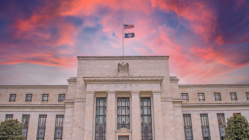
This may be the most important blog I write all year because it will impact how readers invest and plan for the future – and it openly refutes the mainstream narrative we are seeing everywhere right now.
Another bank failed last week, and today we learned that a major U.S. trucking firm (Yellow) is on the verge of collapse.
These failures are just two examples of the lag effect of the Fed’s rate increases that are starting to surface – and we will inevitably see much more of this in coming months.
This is a point that Lacy Hunt made in these two Wealthion podcasts from last week: (1) Brace For A Credit Crunch + A “Serious” Recession and (2) We’re Facing A Perfect Storm Of ‘Economic Deterioration.’
Mr. Hunt is an 81-year-old PhD economist and asset manager ($5 billion) who is extremely well-educated, exceptionally experienced, and well-respected by most everyone.
So, when Mr. Hunt says a soft landing is not in the cards, it very likely means a soft landing is not in the cards.
Fed Chair Powell and all of his supporters last week were doing a victory dance of sorts, proclaiming that the Fed actually pulled off a miracle by raising rates, stemming inflation, and staving off a recession all at the same time (creating what is called a “soft landing” from the rate increases).
The Wall Street Journal, the Financial Times, and the New York Times all recently had gleeful headlines telling readers that the U.S. in fact Is Sticking The Soft Landing.
The Fed of course loves this narrative because it makes for an awesome legacy, it helps politically, and it creates a narrative that keeps people and businesses hiring and spending (many people believe that economic results are nothing but a result of psychology, and that psychology can be manipulated with narratives – whether true or false).
The soft landing narrative though is extremely dangerous, per Mr. Hunt, because it can cause so much financial harm to businesses and consumers – if they over-hire, expand too quickly in anticipation of more growth, spend too much, borrow too much or fail to save for the rainy days to come.
For those of us in the mortgage and real estate industries, it matters tremendously because we so desperately need lower rates to free up inventory (sellers are sitting on inventory, waiting to list when rates drop), to make housing more affordable (bringing more buyers into the market), and opening up the refi spigots.
So, while I highly recommend listening to Mr. Hunt’s full podcasts, I will summarize a few key points below. What is interesting and very telling is that they mimic the points Jeff Snider has been making for months.
Gross Domestic Income has been down for three of the last four quarters – a major recession harbinger that Snider alludes to as well.
GDP was up because of autos, but that will be short-lived. Hunt says automobile manufacturing was the last sector to recover from COVID and that there was a temporary surge in auto manufacturing because of this fact, and that is the primary reason that GDP grew so much in Q2. But – it was a one-time event and won’t repeat because the sector was merely playing catch up.
Manufacturing outside of autos has been consistently declining.
Corporate bankruptcies are increasing, and corporate profits are down.
Federal income receipts are way down (another recession harbinger and a topic that Snider hit hard).
And lastly – China, Japan, and Europe are struggling mightily (Snider’s points too).
Monetary Lags And Interest Rate Lags
The lag effect is the main reason Hunt believes a recession will hit for sure, as we have not come close to feeling the full effect of higher rates and a shrinking money supply.
Very low rates fostered record debt levels for companies, businesses, and consumers, as all borrowed with reckless abandon.
But – they have been OK up to now because their interest expense has remained so low because they have not been forced to refinance their short-term debt with today’s much higher rates.
They are, however, now facing that reckoning – and that is why governments, businesses, and consumers (credit card debt) are now facing so much peril – few can afford the much higher interest expense they will soon be facing.
Similarly, bank lending and/or credit creation is probably the single biggest driver of economic activity, but there is a coming credit crunch (that always comes with a tighter money supply) that will slow economic growth tremendously, or halt it altogether.
Government Spending Only Works In The Short Term
A lot of pundits like Chamath Palihapitiya and Paul Krugman fervently believe that government spending like the Inflation Reduction Act or the CHIPS Act will foster economic growth. But, Mr. Hunt points out that deficit-financed stimulus only works in the near term; after about 6 quarters it actually HURTS economic growth.
This is something that few people understand, but when governments with too much debt borrow to stimulate economies, they do more harm than good, and China and Japan are great examples.
I could list a lot more data that Mr. Hunt alludes to but will stop here because I think I have made my point.
And yes, I know I beat the recession dead horse way too often – but I had to get out my bat again because of all the “soft landing” headlines that surfaced late last week.
Per Mr. Hunt, we will see a recession without a doubt – so rates will fall, today’s buyers will be able to refi, more buyers will be able to come back to the market, and inventory will spike.
Get ready for a raucous 2024!
























